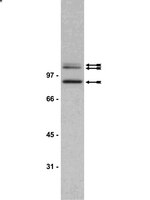Transformation-sensitive changes in expression, localization, and phosphorylation of adducins in renal proximal tubule epithelial cells.
Fowler, L, et al.
Cell Growth Differ., 9: 177-84 (1998)
1998
Show Abstract
Adducins are cytoskeletal proteins that facilitate interactions between spectrin and actin to form the subcortical membrane skeleton. We recently determined that alpha- and gamma-adducins are among a group of PKC substrates that we have designated "STICKS" (substrates that interact with C-kinase). To study the role of adducins and their regulation by protein kinase C (PKC) in carcinogenesis, we compared the content, localization, and phosphorylation of alpha- and gamma-adducins in primary renal proximal tubule epithelial (RPTE) cells and oncogene-altered derivative lines. RPTE cells expressing adenovirus E1A are immortalized but not transformed, whereas RPTE cells expressing SV40 large T antigen are transformed. Phosphorylation of adducins was monitored with a phosphorylation state-specific antibody directed toward the PKC phosphorylation site on adducins. Basal levels of phospho-alpha-adducin were relatively low in growing and confluent primary RPTE cells; however, basal levels of phosphoadducins relative to total adducins were increased in E1A-RPTE and SV40-RPTE cells. Phorbol esters stimulated alpha-adducin phosphorylation to a greater extent in primary cells than in oncogene-altered cells, possibly because of the already high basal levels of phosphorylation in those cells. Phosphorylated adducins were preferentially recovered in the soluble fraction, indicating that PKC phosphorylation either directly or indirectly influences the subcellular location and functions of adducins in regulating membrane skeleton structure. Thus, these studies provide evidence for increased endogenous PKC activity in oncogene-altered cells and suggest that the increased activity directly influences cytoskeletal organization by phosphorylating regulatory proteins, such as the adducins. | 9486854
 |
35H, a sequence isolated as a protein kinase C binding protein, is a novel member of the adducin family.
Dong, L, et al.
J. Biol. Chem., 270: 25534-40 (1995)
1995
Show Abstract
We recently cloned a partial cDNA (35H) for a protein kinase C (PKC) binding protein from a rat kidney cDNA library and demonstrated that it is a PKC substrate in vitro (Chapline, C., Ramsay, K., Klauck, T., and Jaken, S. (1993) J. Biol. Chem. 268, 6858-6861). Additional library screening and 5' rapid amplification of cDNA ends were used to obtain the complete open reading frame. Amino acid sequence analysis, DNA sequence analysis, and Northern analysis indicate that 35H is a unique cDNA related to alpha-and beta-adducins. Antisera prepared to the 35H bacterial fusion protein recognized two polypeptides of 80 and 90 kDa on immunoblots of kidney homogenates and cultured renal proximal tubule epithelial cell extracts. The 35H-related proteins were similar to alpha- and beta-adducins in that they were preferentially recovered in the Triton X-100-insoluble (cytoskeletal, CSK) fraction of cell extracts and were predominantly localized to cell borders. Phorbol esters stimulated phosphorylation of CSK 35H proteins, thus emphasizing that sequences isolated according to PKC binding activity in vitro are also PKC substrates in vivo. The phosphorylated forms of the 35H proteins were preferentially recovered in the soluble fraction, thus demonstrating that phosphorylation regulates their CSK association and, thereby, their function in regulating cytoskeletal assemblies. We have isolated another PKC binding protein partial cDNA (clone 45) from a rat fibroblast library with substantial homology to alpha-adducin. Antisera raised against this expressed sequence recognized a protein of 120 kDa, the reported size of alpha-adducin, on immunoblots of renal proximal tubule epithelial cell extracts. A 120-kDa protein that cross-reacts with the clone 45 (alpha-adducin) antisera coprecipitated with 35H immunecomplexes, indicating that alpha-adducin associates with 35H proteins in vivo. Taken together, these results indicate that 35H is a new, widely expressed form of adducin capable of forming heterodimers with alpha-adducin. We propose naming this adducin homologue gamma-adducin. | 7592723
 |









